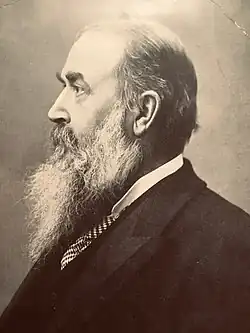George Armstrong (surveyor)

George Armstrong (6 March 1843 – 7 January 1910) was a Scottish surveyor who worked with the Palestine Exploration Fund for 38 years.[1] and was part of the PEF Survey of Palestine. Armstrong "played a key role in compiling the PEF's maps and editing the textual publications",[2] and compiled one of the most notable nineteenth-century maps in the history of the cartography of Palestine.[3]
Biography and career
Armstrong was born on 6 March 1843 in Newcastleton, Roxburghshire, Scotland.[4] He joined the Royal Engineers in April 1860[4] and in 1861 was stationed in Glasgow, working for the Ordnance Survey mapping agency.[5] By 1871 he had been promoted to Second Corporal.[6]
In 1871, Armstrong was part of the party who conducted the Survey of Western Palestine, under Captain Richard Warren Stewart and alongside Charles Frederick Tyrwhitt-Drake.[7] He later worked under Claude Reignier Conder and Herbert Kitchener, who joined the group in 1872 and 1874 respectively. Armstrong is mentioned in Conder and Kitchener's account of the fieldwork, The Survey of Western Palestine (Memoirs of the Topography, Orography, Hydrography, and Archæology)[8].
In the winter of 1883-4, Armstrong took part in the geological survey of Eastern Palestine.[9]
In 1889, Armstrong published Names and Places in the Old and New Testament and Apocrypha,[10] a guide for identifying locations mentioned in the Old Testament, New Testament, and Biblical apocrypha. Revised by Charles William Wilson, the book has been described as being "central to British colonial toponymic projects in Palestine in the late 19th and first half of the 20th century"[11] by Palestinian writer Nur Masalha.
Armstrong's raised map of Palestine was the first of its kind and won a medal at the Louisiana Purchase Exposition (also known as the St. Louis World's Fair).[12]
Armstrong had taken over from Walter Besant as the PEF's Acting Secretary in 1887[13] and remained in post until a few weeks before his death on 7 January 1910.[14]
References
- ^ C., J.D. (1910). "Memoir of George Armstrong". Palestine Exploration Quarterly. 42 (2): 97–98. doi:10.1179/peq.1910.42.2.97.
- ^ "Palestine from the Surveys Conducted for the Committee of the Palestine Exploration Fund (P.E.F.) and Other Sources". exhibits.stanford.edu. Retrieved 14 August 2025.
- ^ "Composite Map: P.E.F. Palestine, sheets 1-16, 19-23". David Rumsey Map Collection. Retrieved 15 August 2025.
- ^ a b C, J. D. (1910-04-01). "Memoir of George Armstrong". Palestine Exploration Quarterly. 42 (2): 97–98. doi:10.1179/peq.1910.42.2.97.
- ^ "George ARMSTRONG, Ordnance Survey People". Ordnance Survey People. Retrieved 29 April 2025.
- ^ "George ARMSTRONG, Ordnance Survey People". Ordnance Survey People. Retrieved 5 May 2025.
- ^ Conder, Claude Reignier (1999). Tent Work in Palestine: A Record of Discovery and Adventure. Adegi Graphics LLC. ISBN 978-0543689924.
- ^ Conder, C.R; Kitchener, H.H. (1881). The Survey of Western Palestine : Memoirs of the Topography, Orography, Hydrography, and Archaeology. Vol. 2. London: Committee of the Palestine Exploration Fund. OCLC 5785377.
- ^ Besant, Walter (1889). Twenty One Years' Work in the Holy Land, A Record and a Summary June 22, 1865-June 22, 1886. London: Palestine Exploration Fund. p. 114. ISBN 978-1334407345.
{{cite book}}: ISBN / Date incompatibility (help) - ^ Armstrong, George (1889). Names and Places in the Old and New Testament and Apocrypha. London: Alexander P. Watt.
- ^ Masalha, Nur (2018). Palestine: A Four Thousand Year History. Zed Books. p. 252. ISBN 978-1786992758.
- ^ "Museum With No Frontiers - Sharing History: Sharing History Arab World – Europe | 1815 – 1918". Museum With No Frontiers. Retrieved 29 April 2025.
- ^ Moscrop, John James (1 March 2000). Measuring Jerusalem: The Palestine Exploration Fund and British Interests in the Holy Land. Leicester University Press. p. 84. ISBN 978-0718502201.
- ^ "Notes and News" (PDF). Palestine Exploration Fund Quarterly. 42 (2). April 1910.